#too many characters to individually tag
Note
Do you have any age headcanons for some pokemon characters like for example the train men, N, Lysandre, ect?
Well, there's a few with canon ages.
N is confirmed to be like 20-22 and Cyrus is a beautiful baby boy at 27.
Lysandre is probably in his early 40s (maybe 42?) alongside Sycamore since they're clearly around the same age.
Ingo and Emmet are in their early 30s to me nowadays (despite my previous thoughts, I've stated), and Warden Ingo is maybe... I go between a few ages. The joke answer is he's just 37 and going through it hard, but it's probably mid 40s+ (and that, too, applies to Silver Fox Emmet, of course.)
Nanu is... something I don't want to give actual thought. Late forties to early fifties, maybe? 48-52 is the range I'd give.
Grimsley varies, too? He's clearly maybe mid to late 20s in BW... but, uh, idk about in Alola? Something either happened to him, or he had a rough time in like 2 years. Because... SM apparently is just two years after BW2. Help him.
Colress is hard in his 30s. Somewhere. Not sure. Just pick a random one in that range, and I'll probably agree. He just seems a more into his career and far out of whatever university had him. 33, I guess in BW2, so he gets to be 35 and insane in Alola.
Maxie and Archie also fluctuate for me. They are either in their late thirties or just turned 40. Actually, maybe Maxie is like 39 while Archie is 38 or something. I don't know. They just seem older but not too old? Especially their Gen 3 designs... I don't think there's that much age variance between ORAS and RSE them, though. Them again, with the Cyrus situation, they both might just be 25 lmao.
Guzma is over 20, and that much is certain. He and Kukui (and Molayne) are all around the same age, so I like to imagine he's like 23 doing all that sjajdns.
Volo is 27 to me because it would just be hilarious that being in Hisui/Sinnoh and being that age makes you want to climb that damn mountain. Though, I also do think he's in his mid-20s in general.
My controversial take is that I see Irida as 18 at the youngest. She's the head of her clan, and her close friendship with Palina makes me think they're close in age. And I see her age as close to Adaman's own, too, but maybe just a little younger to make her feel more of a need to prove herself to him. I think they would also prefer an adult to be head of the clan, too.
Elesa is maybe... 24-26? Hard to explain why. Just seems in that range.
Cynthia is probably around Cyrus's age, so 26-28. They seem maybe a little acquainted before all the stuff in DPPt, so I think they may have met a few times, maybe at a university or in school.
Larry is like 48-50. He's been confirmed to have worked for the Paldea league for 25 years, so it just seems likely he may joined up after he graduated.
20 notes
·
View notes
Text
To Comfort The Moon









A lil doodly comfort crumb from this AU. I swear it's more lighthearted than this! ....Mostly, anyway.
Usually, comments like that slide right over Moon, it doesn't really bother him, that day was just a bad one, and the kids weren't feeling as nice as they usually do. It happens. And they know they have each other to just be there! They're not alone.
Most of the Daycare space is canon compliant, with a few extras just because; in this case, Moon's Nap Corner! While most kids prefer being outside of the little nook, some feel safer inside, which is why it exists :)
I was debating whether to add the other important guys in this comic, but decided that this moment happened prior to their intro, or there are plot related reasons they're not here! It doesn't really matter... ^^'
Under the cut is the comic without dialogue! I feel like it's still understandable without it, and I kinda prefer it anyway, so I decided to post! Anyways, see you when I actually introduce the others correctly! (Aka post their refs) :>









#fnaf au#I haven't named it yet?#tentatively calling runecare for now#runecare au#tags will change when i find a better name#fnaf sun#fnaf daycare attendant#fnaf sundrop#fnaf daycare au#moon fnaf#fnaf sun and moon#fnaf sun x moon#fnaf security breach#fnaf fanart#fnaf sb#fnaf moon#fnaf moondrop#sundrop fnaf#fnaf dca#they have soooo many tags sigh#rune posts?! impossible#rune draws#the nook is messy because their shift just ended#that's my excuse and im sticking to it#its definitely not because i hate drawing bgs not at all#also fyi i wont use that many individual character tags next time#feels like too much#...hopefully i'm not lying about that
416 notes
·
View notes
Text

Actually, what if they all had tails?
Specifics under the cut:
Joy - Dog. Good for wagging when happy.
Anger - Dragon. Pretty self explanatory.
Fear - Cat. Puffed up 99.9% of the time.
Disgust - Rat. Thought to be gross creatures but are actually one of the neatest.
Sadness - Snow Leopard. Icy, cold, the tail simply drags on the ground behind her.
Anxiety - Lion. Courageous. I count this one as per-existing even though I can't find the original image I saw of her with a tail.
Envy - Squirrel. Just for the cuteness. Her tail is larger than she is.
Ennui - Monkey. Prehensile tail for holding things and hanging off stuff.
Embarrassment - Bear. C'mon, it's right in his name. Stupidly adorable just like him.
#torras art#inside out 2#io2#hhh I don't wanna tag the individual characters sorry#too many#[casually furrys your emotions]#this is what they'd look like in my head#wait no in my head they'd all be tigers lmao#my joy looks so wonky I'm sorry#she's the hardest to draw#she's the most human-like design wise#except maybe disgust#it's the hair...
223 notes
·
View notes
Text

my piece for the @yorknewauction reverse bb! @hurtinghabits wrote a fic based on this which I am very excited to buckle down and read very shortly 👀
#hunter x hunter#hxh#i am like 99% sure the 2011 anime uses melody's voice actor for the radio broadcaster and that concept was very intriguing to me haha#was also fun to focus on some characters i don't draw too often (the pt gals <3 and kortopiiiii :'D)#tooooo many characters to tag individually though so i will do the giant tag for search purposes again ^^;#gon freecss killua zoldyck melody leorio paladiknight nobunaga hazama chrollo lucifer machi komacine pakunoda kortopi shizuku murasaki
836 notes
·
View notes
Text

#tsams#sun and moon show#the sun and moon show#lunar and earth show#mgafs#the lunar and earth show#tmgafs#laes#tlaes#the monty and foxy show#monty and foxy show#the monty gator and foxy show#monty gator and foxy show#too many individual characters to tag
149 notes
·
View notes
Text
LSTR-S2301 and the maintenance tunnel ARAR are best friends to me even though that Elster was only on sierpinski for a seemingly brief time, they’re bros who fuck around on the clock during work. I think Elster was probably more willing to put extra time in however she’s also very “okay you’ve given me a list of tasks I did them. They’re done and done well. That’s it, my time now.” Whereas I see Ara being more of a slacker (very valid of her) or at the very least just a bare minimum type of gal when it comes to work.
Idk I tend to imagine them fucking off in the middle of shifts to go find weird lonely corners of sierpinski to hang out in. They don’t even talk half the time but they love it.
#listen I know sierpinski Elster has Alina as her lover#I don’t necessarily see Elster/ara as romantic although it could be#they’re just tired work bros to me#u have machine autism and plant autism and they’re both silent types I think they’d click#I’ve seen some fun takes on Lilith and Elster as characters too#to me Lilith Itou is definitely the strong silent type but not bc she always means to be#yes she is an intimidating war veteran but I think part of that intimidation factor comes from her being awkward as hell when it comes#to talking#combo of awkward/ just being a woman of few words anyway#which comes through in LSTRs I think#they don’t say much when they don’t feel that they need to ig#anyway idk if this makes sense I’m just rambling#I was also just trying to think abt LSTR-S2301 bc poor thing#imagine being your own individual replika but you’re brought to this place as basically a sacrificial lamb? of sorts#in that you as you are. it’s not what you need to be for a god’s purpose#but it’s close enough that the parts that aren’t needed can be stripped away#and filled again#she was only ever meant to be a vessel for 512 in many ways#but she was still S2301 and had her own life and friends for a brief moment in time#signalis#this isn’t worded well but gets the tag regardless#I should make a rambles tag separate from my personal tag maybe#lynx rambles#<- new tag ig
59 notes
·
View notes
Text

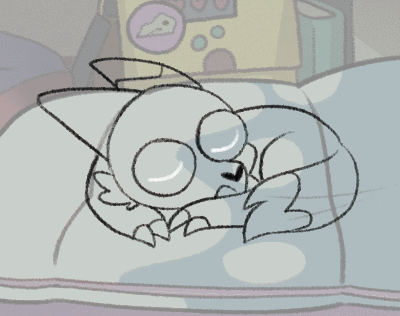

random note about king on that animation, i got really lucky with how simple his animation was and how clean my sketches were to begin with that i was able to do very minimal cleanup on what i had sketched (and add back. his horn. it's supposed to take place just after echoes of the past, Oops) and call it done that way instead of having to redraw the entire thing like i had to on his dad
first sketch > line cleanup > nearly final animation (i'd added slight eye movements last-second but otherwise that's the final)
#toh#the owl house#animation#gif#king clawthorne#the lineart slightly flickers on his one paw where i had to erase the tag and i thought it would bother me a lot more#but most people seem to use the internet on their phones - coupled with the darker palette and color of his fur#it basically completely hides it#based on feedback i don't think a lot of people realize i made that and it's not a gif from the show lmfao#BUT ITS STILL REALLY NICE THAT PEOPLE THINK IT IS!!!! I AM NOT AN ANIMATOR I AM JUST A HOBBYIST...#i animate like once a year... shits hard man.... but apparently when i do animate. its extremely good :) proud of that#even if i have an extremely unhinged way of animating#i don't have an animation program i draw everything individually frame by frame in photoshop#each character had their own psd file with the same background and every frame was its own group. twice. one for sketch one for colors#i do test takes with gifcam (there are literally 55 WIP gifs in my documents folder rn) by switching between layers and taking a 'frame'#and i compile in blender's video editor and to move things separately i save each character's frame in its own .png 'cel'#so luz was her own 'cel'. king was his own 'cel.' etc. and then i have to manually slide the lengths of the frames around#to match the right framerate. traditionally animation is animated at 24 FPS on 2's - so 12 frames a second. i go on 3s. 4 to slow down#anime-ass framerate. i'm insane apparently but its what i like to do#i dont understand real animation programs they have too many pieces but i DO understand photoshop and my funny brushes#imagine having Digital Programs and Still basically doing ye olde traditional animation method just in the computer#if im Just making a gif then i only use gifcam and switch between layers. like digital stop motion. somethings wrong with me
331 notes
·
View notes
Text
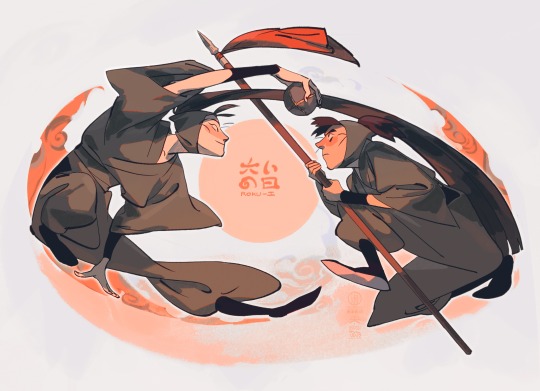
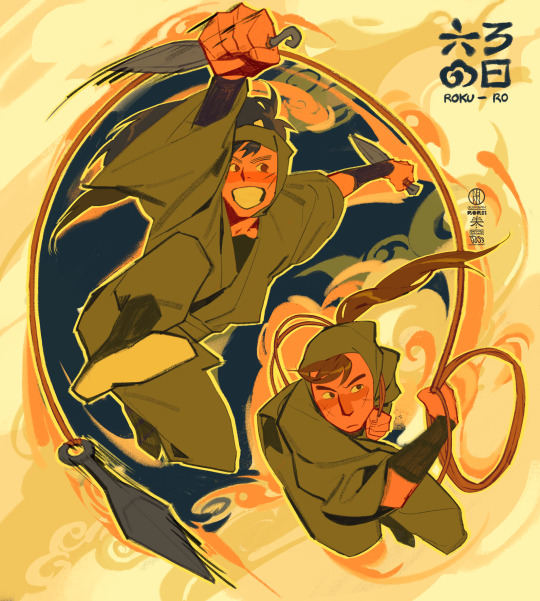

i! ro! ha! (six years edition)
#忍たま乱太郎#nintama#nintama rantarou#rkrn#quirinahdraws#digital#六い#六ろ#六は#tachibana senzou#shioe monjirou#nanamatsu koheita#nakazaike chouji#zenpouji isaku#kema tomesaburou#i am so normal about my six favorite characters in the series (liar)#the six years r like my pookies i love them...im trying to draw as much as possible for this character month (totally insane)#sorry if you follow me anywhere else and had to witness the insanity that is trying to draw daily (HELP ME)#i wanted to continue the trend with the fourth years of their illustrations all having different vibes but i feel like my vision wasnt supe#clear so theyre all a little more similar ORZ...the recurring cloud motifs r fun thou#i like circle compositions.#GUYS. BEING ON TWITTER IS SO INTIMIDATING THERES SO MUCH GOOD ART HELP ME#oomf made a whole amv for rokuha day.......my fakefan era...#are your faves even isaku and tomesaburou if you didnt make an entire ANIMATIC#i like how the room duos all have like the one guy whos sort of outwardly put together but has a short n quick fuse#and their chaotic kind of disaster counterpart whos actually pretty emotionally stable and grounded#they balance each other out nicely AND THEY HAVE A CLOSE RANGE AND FAR RANGE WEAPON GUY#i feel like their individual class duos r so nice together.....but i feel like the six years have so many fun combis too#they bounce off each other in fun ways AHEM HEM KENEN HEM HEM CHOUGOUGUMI AHEM TRAINING TRIO AHEM#TAG LIMIT ARGHRHGRGRHGHRGHRH trust me when i say i have infinite love for these idiots in my heart
52 notes
·
View notes
Text
Guys! Yesterday I had a book-shaped piece of mail, and inside of it was my copy of Children and Childhoods in L.M. Montgomery: Continuing Conversations being returned, from another very dear user here! I bring this up only because some-months-ago I promised to copy out a particular article from this book, for yet another user here, who was interested! Interested because it’s on the the subject of a Fan Favourite thing... fan fiction. And better still because some of our (basically famous) mutuals here are mentioned by name! If you’ve ever wondered if the Montgomery scholarship is reading your fan fiction... the answer is yes, they are! They totally are. More than that, they also have some thoughts to share… as well as recommendations of their faves too! This article even covers the F/F and M/M fan fiction presented by fans in LMM’s universe, and I’m personally super excited to be able to begin reading these works, as soon as I can find them all. I’ve done my best to link what I could immediately find, but some of the mentioned stories were unavailable... potentially due to changes in usernames? (That said... if anyone knows of the works indicated here, that I haven’t provided a link for, please do share!)
This article, by the way, was written recently... in 2020! It’s very current, and it covers a few stories that were still being actively updated during the pandemic. The focus of this article is less so on canon (or really just the Anne/Gilbert pairing), though, and seems to prefer demonstrating the versatility of mixing relationships (Anne and Emily, for one!) and the wider more general universe-building aspects (the entanglements of future generations/Anne’s grandchildren) that fans have been expounding on for nothing less than decades.
Okay, here we go! xx
Continuing Stories: L.M. Montgomery and Fanfiction in the Digital Era by Balaka Basu
Fanfiction – the recreational (re)writing of texts – is a literary genre of rapidly growing significance. Abigail Derecho in her brief history of fanfiction identifies it as “a genre that has a long history of appealing to women and minorities, minorities, individuals on the cultural margins who used archontic writing as a means to express not only their narrative creativity, but their criticisms of social and political inequities as well.”
Insightfully defined by Francesca Coppa and Mary Ellen Curtin as “speculative fiction about character,” fanfiction can be even more precisely understood as fantasies about the diegetic positioning of characters in the context of various settings, communities, relationships both textual and paratextual, and eventually all manner of cultural mythologies.
Kristina Busse and Karen Hellekson describe the production of fanfiction as “part collaboration and part response to not only the source text, but also the cultural context within and outside the fannish community in which it is produced.”
They point out that the shift in the method of dissemination of fanfiction from newsletters and zines to internet archives means that “ever-younger fans who previously would not have had access to the fannish culture except through their parents can now enter the fan space effortlessly; financial resources have become less of a concern because access to a computer is the only prerequisite; and national boundaries and time zones have ceased to limit fannish interaction.”
The nature of fanfiction allows participants to cross-generational and socio-economic boundaries in an ongoing exchange of responses to a source text with which they share a fascination, developing new texts that in turn elicit their own responses. While the creation of fanfiction is evidence of an affective, loving, communal relationship with the source text, this genre of writing is still dismissed in many quarters as overly emotional, purely erotic, and even perverse, a type of amateur and immature engagement with popular texts that produces writing necessarily divorced from literary significance. Produced in staggeringly vast quantities by subcultures with complex vocabularies and traditions that can intimidate the casual reader, fanfiction is perceived by many to be more of a cultural practice than a literary genre, variously denigrated for its pornographic potential and its lack of originality. However, close examination reveals that fan writers are able to create a critical dialogue with the originating author in acts of communal storytelling that incorporate allusions and reference points to which other dedicated fan readers and writers may respond.
In this chapter, after examining how L.M. Montgomery and her writer heroine Emily themselves engage in practices now associated with fanfiction, I survey four forms of fanfiction that remove Montgomery’s novels from her seemingly idyllic and timeless island settings, contextualizing her characters and plots within history and other genres: the sequel set during the Second World War, the modern AU (alternate universe), the gap-filler, and the slash fic, all of which allow the young readers who grow up with her novels to engage in dialogue with the stories they love, a type of literary conversation that Montgomery herself models within her texts. Emily’s reading, which is active rather than passive, resembles twenty-first-century fans’ ownership of the texts they love, provoking creative responses. For instance, after reading works by Lord Tennyson, Elizabeth Barrett Browning, and Matthew Arnold, Emily writes, “Teddy lent me 3 books of poetry. One of them was Tennyson and I have learned The Bugle Song off by heart so I will always have it. One was Mrs. Browning. She is lovely. I would like to meet her. I suppose I will when I die but that may be a long time away. The other was just one poem called Sohrab and Rustum. After I went to bed I cried over it. Aunt Elizabeth said ‘what are you sniffling about?’ I wasn’t sniffling – I was weeping sore … I couldn’t go to sleep until I had thought out a different end for it – a happy one.”
The reactions Emily catalogues are those of the fan; they are viscerally felt in the body and attempt to dissolve the boundary between author and reader, producer and consumer. She inscribes Tennyson within her heart in order to possess the poem she loves; she creates a relationship between Barrett Browning and herself; and, most significantly, she interjects her own desired happy ending into Arnold’s tragic narrative, a corrective desire that is at the core of many works of fanfiction. Emily’s diaries and her story reflect Montgomery’s own experiences from childhood to adulthood as reader, writer, and reader-turned-writer discussed in the introduction to this volume. Depicting Emily as a voracious reader and a life-writer like herself, Montgomery places the child Emily’s voice in conversation with that of the narrator through Emily’s letters to her dead father in Emily of New Moon and through her diary entries in Emily Climbs and Emily’s Quest, creating a form of joint authorship that is referenced explicitly in “Salad Days,” the second chapter of Emily Climbs: “book is not going to be wholly, or even mainly, made up of extracts from Emily’s diary; but, by way of linking up matters unimportant enough for a chapter in themselves, and yet necessary for a proper understanding of her personality and environment, I am going to include some more of them. Besides, when one has material ready to hand, why not use it?”
The narrator’s willingness to use the “material” that is “ready to hand” reflects Montgomery’s and Emily’s practices, and also validates other writers’ use of the material Montgomery places at their disposal. As with many fans, Emily’s reading frequently makes itself felt within her writing.
Like Montgomery, Emily learns her trade through mimicry, from her first poem in blank verse inspired by James Thomson’s Seasons to her unwitting imitation of Kipling that is pointed out by her teacher, Mr Carpenter, in his review of her work. Like Sara Stanley of The Story Girl, whose compelling and fascinating stories are rarely if ever original, Emily is a fan of the oral traditions of her community, incorporating and building upon them in her own writing, transforming and recreating, for instance, the story of “The Woman Who Spanked the King” in Emily Climbs.
The retelling and versioning that Emily practises signal her immense admiration for the source texts she adapts, just as the creation of fanfiction does for Montgomery’s readership and fans. The possibilities inherent in versioning and adaptation are illustrated in Emily’s Quest. When Montgomery depicts Emily undertaking the reworking of someone else’s narrative, she is adapting an episode from her own experience while working for The Echo in Halifax, which she records in her journal. Montgomery, like Emily, was asked to create an ending for a serialized story, “A Royal Betrothal,” after compositors had misplaced the original text.
Like Emily, she claims that her “knowledge of royal love affairs [was] limited,” and that she was unaccustomed “to write with flippant levity of kings and queens.” Nevertheless, Montgomery manages to create a conclusion that passes muster, since “as yet nobody has guessed where the ‘seam’ comes in.” She is, however, curious about the original author’s reaction to her unauthorized adaptation, and while she never discovers this in real life, she does imagine it in her fiction when she introduces Mark Greaves, who is horrified by Emily’s new ending for the story but enchanted by its author. Neither Montgomery nor Emily engages in this sort of writing from a place of fandom; they have no previous attachment to “A Royal Betrothal,” and both are writing professionally. Nevertheless, the ability to solve the puzzle of the story and the weaving of their work into an already extant text are the very project of fanfiction: ludic narrative composition that recalls the way children play make-believe with the narratives they love, reworking and extending them. It is telling that Montgomery uses the metaphor of the “seam” to describe this particular craft. Jane Dawkins, writing about her fanfiction, which is inspired by Jane Austen, describes her fan novel Letters from Pemberley as “an old-fashioned patchwork quilt, where in place of the scraps of fabric reminding one of the favorite frocks or shirts whence they came, there is a line or a phrase or a sentence from one of [the original] books or letters stitched alongside the lesser scraps of my own manufacture.”
Montgomery’s final book, framed by the two world wars, is just such a patchwork sequel, albeit providing only brief glimpses of the characters that readers met as children and who have now grown older. When a version of the book was published in 1974 as The Road to Yesterday, these glimpses, lacking the interstitial materials, became even briefer, mirroring the more forced insertion of beloved characters that the two earlier collections, Chronicles of Avonlea and Further Chronicles of Avonlea, display. Only two of Anne’s grandchildren – Gilbert Ford and Walter Blythe – are obliquely referred to, in the story “A Commonplace Woman,” where an unpleasant young doctor reflects on both of them as potential rivals for the affection of a beautiful girl he himself hopes to pursue.
However, the full novel, The Blythes Are Quoted, published in 2009 and comprised of short stories about the people in Glen St Mary and over the harbour, is interspersed with poetry by both a young Walter and an adult Anne. The poems are cut with tiny slices of dialogue that suggest the continuing lives of fans’ favourite characters and how they might have developed. In “‘Dragged at Anne’s Chariot Wheels’: L.M. Montgomery and the Sequels to Anne of Green Gables,” Carole Gerson notes the mixture of feelings from pleasure to frustration that Montgomery records in her journals as she prepares to write her first sequel.
While Montgomery wrote the first installments of her various series out of inspiration, she was certainly aware of what her market desired from subsequent installments. She often regretted the necessity of marrying off her characters, but was aware that her fans demanded this conventional outcome for the characters they had come to love; these traditionally romantic endings, when not offered by Montgomery herself at the instigation of her publishers, are regularly deployed by contemporary fanfiction authors building on the source texts.
Indeed, long before the original structure of The Blythes Are Quoted was revealed to readers in Benjamin Lefebvre’s afterword, fanfiction writers were spinning off lengthy narratives that included a third generation of young Blythes, Fords, and Merediths dealing with the onslaught of the Second World War. While earlier installments in the Anne series – such as Anne of Green Gables and Anne’s House of Dreams – depict the deaths of Matthew, Anne and Gilbert’s first daughter (Joyce), and Captain Jim, Walter’s death in Rilla of Ingleside is somehow more striking. Unlike Matthew and Captain Jim, he has not yet had time to grow old; unlike Joyce, readers have had opportunities to get to know him as a child in Rainbow Valley and as he grows into young adulthood in Rilla of Ingleside. His death is unnatural and, therefore, all the more horrifying. These two aspects of Rilla of Ingleside – the evocation of history by a nostalgic fictional world that is still tied to real time and the use of high drama, tragedy, and romance – provide fanfiction authors with a model they can use to appeal to the emotions of those readers who are immersed in the next generation of Montgomery characters.
The Second World War, then, provides an entry point into the series for fanfiction authors, who can deploy real history coupled with beloved characters to create a tale that feels absolutely authentic. One example of this is a short story, “The Pen and the Sword,” written in 2007 by MarnaNightingale. Here, mimicking the style of Dorothy L. Sayers’s The Wimsey Papers (a series of Spectator articles published between 1939 and 1940, which interestingly also continue the story of First World War–era characters during the Second World War), MarnaNightingale employs epistolary excerpts and newspaper articles to tell the story of a family going through the horrors of war for a second time. Grounding her fragmented story – like The Blythes Are Quoted, a mixture of genres – in the accounts of novelist Mollie Panter-Downes (1939) and war correspondents Ernie Pyle (1940) and Ross Munro of the Canadian Press (1941), whose articles are attributed to Kenneth Ford, she offers a story that, like Rilla of Ingleside, is anchored to the historical moment, while also nostalgically focusing on the character development that comes from Gilbert Ford’s death, Rilla’s and Faith’s reactions to the war, and the lives of their children. Here war also serves as an opportunity for new experiences, particularly for women and children: Rilla takes a factory job as a machinist, liking it better than working in Carter Flagg’s store; one of Anne’s grandchildren, Susan, plans to be a doctor; and Faith, who worked as a Voluntary Aid Detachment nurse in the First World War, mentions how she can sympathize. As well, the daily tidbits that flavour the pages of Rilla of Ingleside are there: one article, attributed to Anne, includes the recipe for Susan Baker’s war bread, reminding readers of the problems of wartime rationing, even in the Americas. Real life events – like the Canadian forces trying (and failing) to make a beachhead at Dieppe – arouse the passions of the reader. Unlike Austen – who also famously wrote of three or four families in a country town, but kept the Napoleonic wars firmly in the shadows – Montgomery brings the passions and high drama of the world stage into the sleepy villages of Prince Edward Island, which inspire fanfiction spinoffs.
The long novel Cecilia of Red Apple Farm, by a fan author who posts under the pseudonym ruby gillis, also directly reworks passages and scenes from the whole range of Anne books, set in the late-nineteenth century, to The Blythes Are Quoted, set in the early years of the Second World War, to highlight the similarity between her new generation of characters and their ancestors. Cecilia is the daughter of Una Meredith and Shirley Blythe (characters often married off in fanfiction). Like MarnaNightingale, ruby gillis provides period flavouring in the styles of dresses and behaviour and in references to 1940s popular films and songs. Simultaneously, this setting offers new opportunities to her female character: Cecilia wants to be a doctor, and rather than staying in Canada, she joins up to be a nurse in England. She has a series of romances – one with Sid Gardiner (before he marries May Binnie), and one with her cousin Blythe Meredith, who is this generation’s poet – before finally ending up with Marshall Douglas (the son of Mary Vance). Just as Anne initially refuses Gilbert Blythe in favour of Roy Gardner’s resemblance to her ideal man in Anne of the Island, ruby gillis’s Cecilia is fooled by the allure of Sid and Blythe as Roy Gardner–like romantic heroes into believing that she does not truly love her fun, practical, “Gilbert-esque” friend. Published in 2004, Cecilia of Red Apple Farm further illustrates the opportunities presented by reusing and reworking a body of texts through its incorporation of Montgomery’s poem “I Wish You” as the work of Blythe Meredith. Montgomery includes this poem and attributes it to Anne in The Blythes Are Quoted, although ruby gillis could not have known this when writing. The repetition of names and circumstances might seem derivative, but for readers who have read and reread the original books so many times, the extension of the story world is prized, even if – perhaps even because of – its callbacks to the original text. Due to the tendency of fans to fixate on “the good bits” in a reread, these parts can be taken for the whole.
Austen fanfiction demonstrates this aptly. Indeed, Helen Fielding’s second Bridget Jones novel, Bridget Jones and the Edge of Reason (1999), illustrates just such a reading of Pride and Prejudice: she shows Bridget, a fan, watching the scene from the 1995 mini-series in which Darcy, dripping in a wet see-through shirt, exits the lake, and then rewinding and rewatching the scene multiple times. How many times might a similar fan reread Walter’s letter from Courcelette? This repeated reviewing of selected portions can replace the amplitude of the original novel. With this delimited focus, narrative is no longer seen as a progression, but as a single moment of pleasure, sustained as long as possible. Reading the Second World War as a repetitive sequel to the First World War further highlights this possibility.
Even Montgomery seems to do so, as demonstrated in The Blythes Are Quoted, with its new generation of characters confusingly named after the old: Walter, Jem, Rilla, Di, Anne, and Gilbert. A variation on Marah Gubar’s kinship model, this kind of continuation highlights the blurred boundaries between child and adult characters who are literally related to one another and whose adventures mimic one another.
In a third example of fanfiction set during the Second World War, Weeping May Tarry, a long novel by ElouiseBates, Meggie, the heroine, is Shirley’s daughter (and also, surprisingly, Paul Irving’s granddaughter). In this story, which like Cecilia of Red Apple Farm is an installment of a longer series, Meggie is sent off to a conservatory of music to study singing, aptly combining the traditions of the nostalgic boarding-school novel with “Girl’s Own” wartime fiction. Following the tradition of Magic for Marigold, which explicitly suggests in its second chapter that the Murrays of Blair Water and the Lesleys of Cloud of Spruce exist in the same universe, @e-louise-bates (like many other fanfiction authors, including ruby gillis) suggests that all of Montgomery’s characters exist in a single universe: Meggie partners briefly with the grandson of Sara Stanley (The Story Girl and The Golden Road) and is close friends with Jane Stuart (Jane of Lantern Hill).
Going even further, @e-louise-bates introduces the grandchildren of the What Katy Did series as friends for Meggie and includes Betsy from Dorothy Canfield Fisher’s Understood Betsy as Bruce Meredith’s wife, creating a world where all the characters of early-twentieth-century girls’ fiction seem to have truly lived, where their descendants must cope with victory gardens and dances with soldiers at the Exhibition Grounds, and where kisses are much more commonplace than they once were.
These particular continuers of Montgomery are also desirous of membership in the community of her fans, seeing their literary endeavours as productive of approval from a fellow readership. Likewise, the novels are notable for their sociality – they seem to offer the reader not only a fantasy friendship with the characters themselves but also the very real society of fellow readers of the works. Thus, these fan authors attempt to diversify their stories so that they represent contemporary beliefs regarding multiculturalism; ruby gillis, for instance, introduces into the family by way of marriage a French girl who has had to flee the Nazis due to being Jewish, a situation Montgomery and her contemporaries might have had some difficulty accepting, considering early-twentieth-century attitudes toward interreligious marriage and Montgomery’s othering of the German-Jewish peddler who sells Anne green hair dye.
The Second World War thus offers writers of Montgomery fanfiction the loom on which to weave new, more diverse stories, even as The Blythes Are Quoted, which also traces the characters’ reactions to this new war, demonstrates how these readers-turned-writers followed Montgomery’s own trajectory, not knowing that they were doing so. On the subject of fanfiction, young-adult author Patricia C. Wrede writes: “The thing that fascinates me about fanfiction, though, is the way that it models the decision tree that writers go through (whether consciously or unconsciously) to get to their final product. For those of us who do this part mostly unconsciously, it can be interesting and instructing to see the multitude of alternate paths that a story could have taken, all laid out more-or-less neatly in different authors’ fanfics [… taking a slightly different fork in the road] resulting in the plot veering in a completely new direction. Friends become enemies; enemies become friends; goals and objectives and results shift and change.” Within these pieces of fanfiction, then, fan writers are able to follow these decision trees with subsequent generations of characters as well.
Another avenue of access occurs when fan authors transpose historical narratives into the contemporary moment. Perhaps the best-known example of this modern alternate universe [AU] conversion is the television program Sherlock, which takes Arthur Conan Doyle’s Victorian detective into the twenty-first century. While new cultural contexts appear, the essence of character is meant to be retained. Just as Sherlock uses text messages and blogs to substitute for telegraphs and handwritten journals, fans of Montgomery reimagine the relationships between her characters as if they were taking place online.
For instance, “Work in Progress” (2012) by verity postulates a friendship between Montgomery’s most famous heroines, Anne and Emily. In this piece of fanfiction, Emily circumvents Aunt Elizabeth’s injunction against fiction during her time at Shrewsbury High by becoming a blogger who is restricted to the “truth.” The story’s online summary, a part of which reads “Anne rolls her eyes. ‘Is your aunt really going to know if you cheat on your nonfiction with some hot prose on the side?’” shows how the story preserves the character qualities that Montgomery laid out, complete with references to the Murray pride and Anne’s orphanhood. Mr Carpenter’s admonitions are spelled out at the beginning of the story:
“Emily Byrd Starr has a sticky note on her desktop. It reads:
ITALICS
CAPITALS
!!!!!
“just”
“really”
CTRL+F!
It is almost like having Mr Carpenter in the room with her.”
Verity creates humour through the juxtaposition of contemporary social media and allusions to Montgomery’s source text. Another story by verity detailing Rilla’s romance with Ken Ford and her friendship with Una Meredith, “Rilla of Toronto,” takes place mainly through instant messages. In this story, Rilla reflects on her life from eighteen to twenty-five, tracing a continuum from her child self to her new adulthood, underscored by verity’s translation of Montgomery’s work into contemporary millennial language.
A third type of fanfiction narrative, the gap-filler, focuses on and expands the implications of the source texts. Moira Walley-Beckett’s Netflix/CBC series Anne with an “E,” as Laura Robinson shows in chapter 12 of this volume, is somewhat fanfictional in and of itself: as Robinson points out, the show fills gaps by bringing to the fore the darker currents that have always been beneath the seemingly untroubled waters of Anne of Green Gables, including Anne’s potential post-traumatic stress disorder from the disturbing life she led before coming to Green Gables. This kind of versioning and adaptation tacitly permits fan authors to feel that their versions are just as valid as those produced by professionals. Gap-fillers frequently expand on romantic pairings and in fandom are often referred to by portmanteaux of characters’ names that perpetuate some inside joke or work as puns. “Shirbert” – a moniker for Anne and Gilbert – is the latter, and demonstrates how fans posting on sites like Archive of Our Own (Ao3), Fanfiction.net, and Wattpad (this last generally populated by younger fans) develop their own language to identify their stories within the community for which they write.
One such story, “You caught me staring, but I caught you staring back,” by Anuka, clearly inspired more by the television series than the novels, begins with an author’s note that reads, “I decided to write some fluff for these two, because I need more Shirbert moments, and season 2 is so far away. I added gifs to make it more vivid.” Here, the romance between Anne and Gilbert as depicted by Montgomery and Walley-Beckett is not sufficient for the reader-turned-writer. Anuka wants the gaps in the narrative to be more fully explored than they are on either page or screen and to be made more “vivid” by the inclusion of images that help make the story come alive.
Similarly, “Rilla Blythe’s Wedding: A Not Entirely Comprehensive Account” by Scylla also fills a gap: Rilla and Ken’s wedding day, a scene that Montgomery leaves to the reader’s imagination at the end of Rilla of Ingleside. Modelled upon other accounts of weddings within Montgomery’s fiction, the story also suggests that accounts of Walter’s death have been gravely exaggerated, as he makes a stunning appearance at his sister’s wedding. In order to align her work with Montgomery’s novel, Scylla ensures that Little Dog Monday’s awareness of Walter’s death remains, but makes it only a technicality, writing, “His heart had stopped for a full ten seconds – long enough for his Captain to feel for his empty pulse and for Dog Monday to be jolted with the fullness of his death. Little dogs, after all, can only have tender dogs’ hearts. Grief to Dog Monday was an all-consuming thing, and when Walter’s heart began to beat once more, he was deaf to its spark of joy.” After meeting with his eldest sister, Joyce, in heaven – which is, as he had always hoped, Rainbow Valley, Walter is returned to life so that he may write of peace as well as war (as he did when he was a boy), marry Una, and repair the broken hearts of readers who did not want to lose him.
While heterosexual pairings are the most prevalent in Montgomery fandom, there is room for queer imaginings as well.
This very popular genre of fanfiction, known as “slash,” is generally defined as stories that centre on samesex romances between characters, particularly between men. Montgomery slash fiction usually stars Walter Blythe.
One slash story, “but i don’t know who you are” by @freyafrida, imagines a bisexual Walter. Told in an enduringly popular sub-genre of fanfiction often referred to as Five Things Plus One (which involves a series of thematically linked but not necessarily chronological scenes), the story is summarized by @freyafrida as “Five people Walter thought he wanted, and one person he didn’t notice until it was too late.”
This last person is original to Montgomery’s text: Una, whose apparently unreturned attraction to Walter is woven through Rilla of Ingleside. The other five potential partners are all alluded to as Walter’s close friends, beginning in childhood with Alice Parker from Anne of Ingleside and Pat Brewster from The Blythes Are Quoted and then carrying on through adolescence and young adulthood with Faith Meredith, Ken Ford, and finally Paul Irving from Anne of Avonlea. While his feelings for Faith and Ken are clearly unrequited, Alice, Pat, and Paul all express their own desire for Walter. The inclusion of the famous poet and Walter’s “model” uncle, Paul Irving, in particular, particular, illustrates how traits of sensitivity and aesthetic appreciation that challenge traditional ideas about masculinity are frequently interpreted as queer by fan readers and writers.
In another slash fiction, cero_ate’s “The Moving Finger Writes, and Having Writ Moves On,” Walter discovers his homosexuality while fighting in Europe:
He wrote half truths and lies once more, when he wrote his Rilla that he could not form poems of the depths of the war. For who could write his sister of the phallic love he had found? He had found his reason in a tow-headed American boy. He meant so much more to Walter than mere friendship could explain. He wanted to write, as sweethearts write, of the tempest of joy in the darkest night. But how would they understand? How would they even try to understand he sought not the Dark Lady of Shakespeare but the youth, fair and Wilde? When he was presented with Una’s faithful heart, he spurned it. When his tow-headed darling presented his own, Walter took it, greedy for him. His grecian style love, the boy who’s [sic] eyes danced, even in the darkest of days. He would do anything to keep him safe. But he could not present him to his family, for their scorn or pity. War had broken him, but made him as well.
While male/male pairings are generally the most popular stories in fandoms, Montgomery’s novels, peopled as they are by communities of girls and women, require that readers who want to queer the text must explore what is called femslash (that is, slash fiction featuring two female characters).
Such relationships have been explored within the academic setting. For instance, Laura Robinson remarks in “Bosom Friends: Lesbian Desire and the Anne Books,” that the relationship between Anne and Diana uses “the language that readers associate with adult romantic love rather than girlhood affections,” even as it is expressed through the heterosexual paradigm of marriage.
One fanfiction author, ArcticLava21, makes it clear that such fan written stories are not speculation but instead address key issues of representation. The author’s note to ArcticLava21’s short Anne/Diana story, “Nature,” reads, “Hello everybody! Hope your [sic] having a wonderful day. Before anyone yells at me for ‘sexualizing platonic friendships’ please note that this is for all those queer kids who grew up pretending. Pretending that he ended up with him instead of her, or desperately wanted representation. Are we good? <3 Enjoy yourselves lovely people.” The intended audience of the story, “queer kids who grew up,” again establishes the transgenerational kinship between Montgomery’s child and adult fans.
All fan fiction, shared on the Internet, exist in dialogue not just with Montgomery’s fiction but with the author herself, and between the fans who read the novels as children and adolescents and the adults that these readers become.
Whether fan writers extend the narrative or fill gaps, transpose chronology or to queer the text, these pieces of fanfiction allow fans not only to insert themselves into the narrative, but also simultaneously to revivify the original novels, published a century ago. In performing interventions to the text, Montgomery’s young fans grow up to reply to the discussions that she began long ago in the pages of her journals and stories, ensuring that all three – author, reader, and text – are continually reborn into a conversation that will never end.
#any typos here are all mine 😑#apologies because i’m sure there’s so many… i’m just bleary-eyed from the screen time it took to type this guy up!#like#why didn’t i just get the kindle version#lucy maud montgomery#fan fiction#anne of green gables#emily of new moon#too many individually referenced characters to tag here really!
52 notes
·
View notes
Text

was rewatching solve it squad returns because i just remembered they exist
#justtrashdoodles#tin can bros#solve it squad#solve it squad returns#im not gonna tag individual characters solely bc ive seen too many version#of scrags name. nope not today /lh#can you tell my fave.
65 notes
·
View notes
Text
(More thoughts and drafting! Some weird formatting I know but it was all one block in my notes)
Emma is doing just fine. Average. It’s really not so bad.
She’s just been dealing with a lot of change. And with too many things not changing.
Which is… an odd thing to struggle with.
Because she likes change. Daunting challenges. The unpredictable. Doing new things every day and never being scared of them. And she likes independence.
She had thought so, at least.
After the show, she had been hit in the face with just how… isolated she was. She had only had two friends before the first season, but she had left them behind. Her mother wasn’t doing the best, and she didn’t have any nearby family.
She found herself laying in her bed in the middle of the day most of the time, scrolling through her contacts and old conversations.
Or scrolling through her comments on TikTok.
A few weeks ago, she had tried some stunt involving a motorcycle and an inflatable pool. She probably wouldn’t have messed it up if her hands weren’t trembling.
(She had forgot to check the breaks, and wasn’t sure if they were working.)
(They were.)
The blood dripping down her face and the gash in her lip didn’t sting as much as it did watching the video.
She looked ridiculous, and she probably always did. It was better when she had someone else to do it with. Maybe she was losing her touch.
She didn’t post the video.
She turned back to dancing instead, which did feel less embarassing, despite the constant mocking feedback. Sure, the jokes were “funny”, but she didn’t care about any of it. She didn’t feel the rush, she wasn’t planning every day, and she wasn’t known or loved for anything.
Except for what she lost.
And, the show, to an extent.
-Ugh, she misses the show. She shouldn’t, but as stupid as it sounds, she really did. She missed doing crazy things and talking to people. Having a chance of winning. Beating everyone. Being cheered on. It wasn’t always great, but at least it was something. She misses doing something.
And she really misses Bowie. She missed Bowie, but she knows better than anyone that she can’t go back to that. They just- have better things to do now. He probably does.
He’s got Raj- which is great! And she’s happy for him! She’s happy for everyone. For Wayne, however he’s doing, for Julia, despite everything.
And Caleb. For having Priya.
Emma is jealous that Bowie gets to have someone.
Emma is jealous that everyone else gets to have someone.
Emma is jealous that, unlike everyone else, winning the show probably wouldn’t have made her any happier.
She isn’t sure what would.
#cw injury mention#(very brief)#writing her always feels weird because I like to explore things that weren’t at all touched in canon#because we only see her as angry at Chase or lighthearted and silly#but I think she’d feel sort of empty. especially with how much attention she would be used to and craving#with Chase and her number of fans. I think she'd struggle with individuality a lot.#and you can't just be super angry and then careless.. like she would have a lot of guilt too#like e4s2 and when Bowie and her fought are what I’m going off of#plus she’s portrayed as a person who wants validation/social interaction/close relationships#and she doesn’t really have that. she doesn't get people and she only really has Chase#also you can’t tell me she loves TikTok and it’s so good for her mental health lol I use TikTok and nobody has ever thought that#but yeah it’s hard to analyze and elaborate on a character who’s been kind of wasted in canon#but still I think there’s so many fun ways to view her#original post#total drama#total drama island#total drama 2023#total drama reboot#td spoilers#technically this is Priyemma based but I won’t tag it as such cus it isn’t obvious. The Priyaleb line hints to that#I think Emma would have gotten really attached to her though.. arghhh.#because Priya trusted her and supported her and liked her and she hasn’t actually had that before. She hadn't been cared about as her own#person. and her missing Bowie… oomph it hurts. auuughgusuughh#gah sorry for ranting lol but I love her#td Emma#Emma td#tdi Emma#Emma tdi#total drama emma#emma total drama
22 notes
·
View notes
Text

To celebrate the return of the Queen, I finally finished a piece that I've had sitting on my hard drive for five straight years, originally sketched before I even finished writing Learnin' the Blues. Hail to the queen, baby!
#art#Joan#Fallout New Vegas#fnv#Fallout#too many characters to bother tagging individually you know who they are#Learnin' the Blues
87 notes
·
View notes
Text
pokespe doodle dump as I try to get used to character designs wee
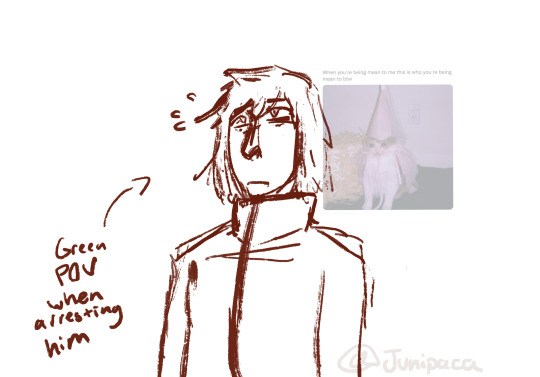
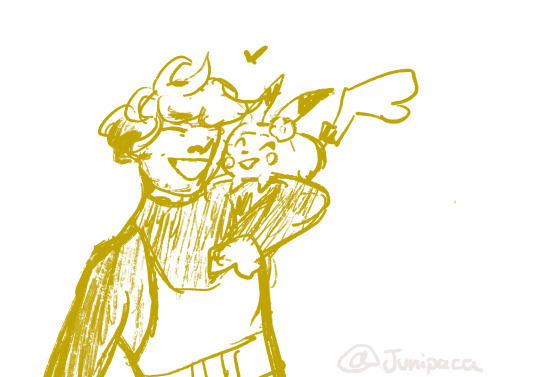


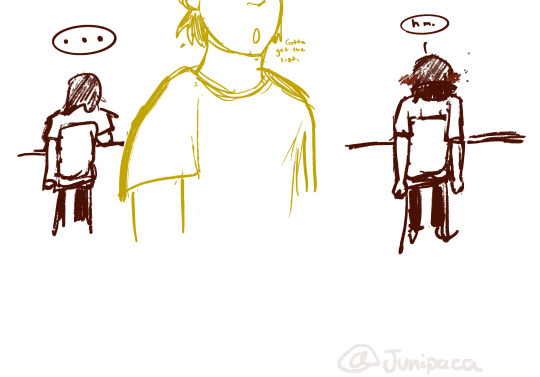
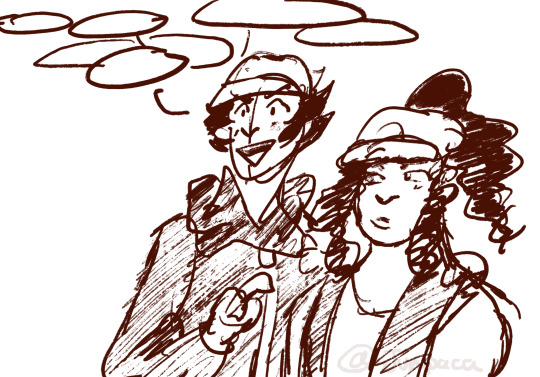

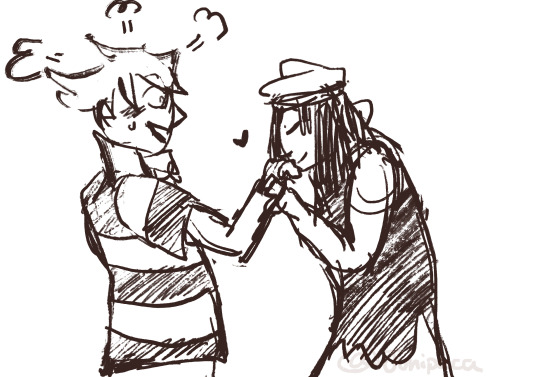



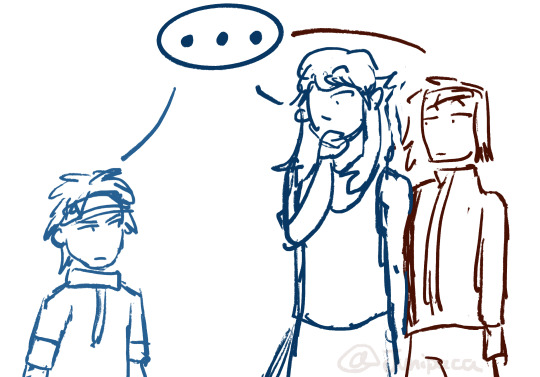
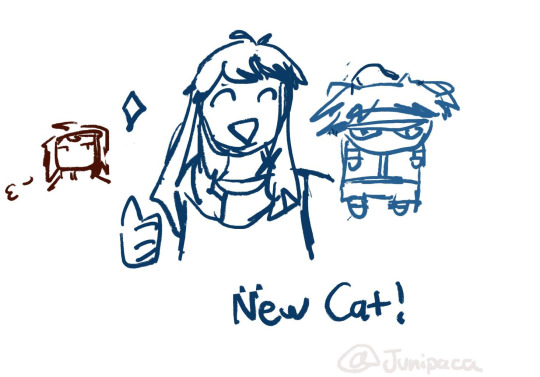
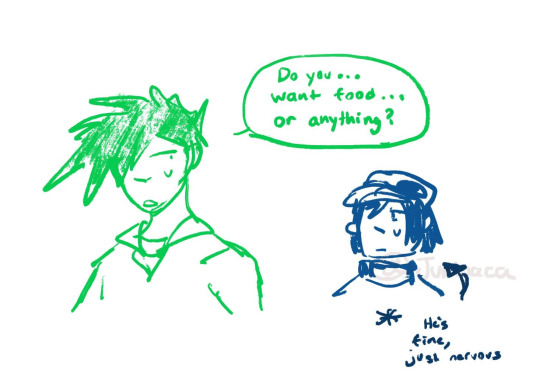
#jj’s art wow#pokespe#pokemon special#pksp#pokemon special adventures#trainer yellow#preciousmetalshipping#entourageshipping#agencyshipping#franticshipping#individual characters are too much here lmao but ill tag the ships#its been so long since i touched this series so i did a giant reread and i have Thoughts weeee#like. so many. opinions too but thoughts are more important lmao#i hope i got the ship names right nods lmk if false or smth
84 notes
·
View notes
Text
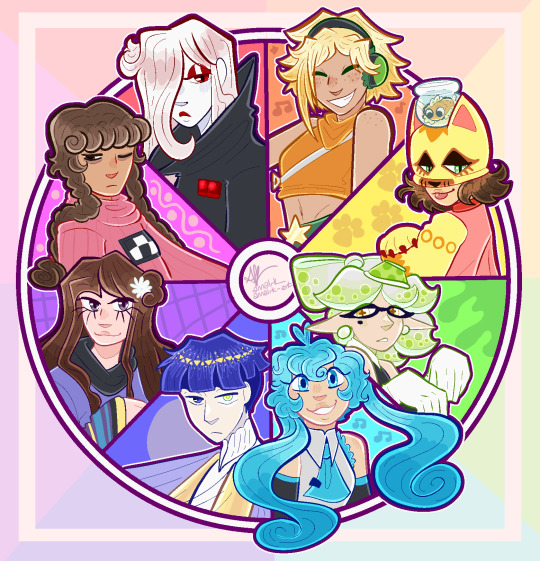
just wanted an excuse to draw these ones tbh
#color wheel challenge#trying human#viva pinata#zero escape#yume nikki#mysims#houseki no kuni#hatsune miku#my art#2023 art#too many characters to all tag individually but if you want any of them tagged specifically lemme know#also i know dj candy is 50% green but idk she's an orange character to me#i haven't drawn shade in years whoopsie
146 notes
·
View notes
Text




Edit: these are old. Swap the places of Old Moon and Nexus/New Moon, and it'd be much more accurate
#tsams#sun and moon show#the sun and moon show#lunar and earth show#the lunar and earth show#laes#tlaes#mgafs#tmgafs#the monty and foxy show#monty and foxy show#the monty gator and foxy show#monty gator and foxy show#too many individual characters to tag
175 notes
·
View notes
Text
Olympic AU fic masterpost/timeline
In case anyone is fancies having a read through what I've been up to over the last 2 weeks, here's a rough order of the updates in the Olympic AU.
Please note that within fics there are SFW and NSFW chapters, I'm listing these by chapter rating, not overall fic rating.
[Johnny/Reg] The Performance of a Lifetime, Chapter 1
NSFW - they meet, and fuck.
.
[Paddy/Eoin] Legato, Chapter 1
SFW - arriving at the Village, Paddy isn't happy with the beds.
.
[Jim/Bill/Pat] Home from Home (from Home), Chapter 1
SFW - Pat spots a young athlete who looks perfect for him and Jim to take under their wing.
.
[Mike/Dave] Grip Strength (oneshot)
NSFW - Dave meets a guy who wants to try a different sort of challenge, and he's definitely up for it.
.
[Johnny/fem!OCs] Team Sports (oneshot)
NSFW - Johnny has some fun with two gorgeous women.
You will need to be logged in to AO3 to view this fic
.
[Johnny/Dave/Mike/Reg] Company, Crowd, Indulgence (oneshot)
NSFW - Dave and Mike join in and have some fun with Johnny and Reg.
.
[Jim/Bill/Pat] Home from Home (from Home), Chapter 2
NSFW - Pat and Jim help Bill enjoy the view of a gorgeous sunset.
.
[Bill/Augustin] 9a+, Chapters 1-4
SFW - Bill doesn't know why Augustin always tries to talk to him, and then has no idea what to do when he finds out. (He makes it worse, of course.)
.
[Paddy/Reg] Taking to the Podium (oneshot)
NFSW - in the fleeting moments of privacy they have after their win, Reg and Paddy celebrate.
.
[Paddy/Eoin] Legato, Chapter 2
SFW - Eoin and Paddy meet again after their first competitions.
.
[Johnny/Reg] The Performance of a Lifetime, Chapter 2
NSFW - before Reg's first competition, Johnny asks if they can celebrate. After... they definitely celebrate.
.
[Paddy/Eoin/Reg] Lap of Honour, Chapter 1
NSFW - the morning after their win, Eoin and Paddy enjoy some time with Reg.
[Johnny/Reg] Lap of Honour, Chapter 2
NSFW - Paddy and Reg go to breakfast in a unique outfit, and Eoin enjoys watches Reg get a rather public and enthusiastic show of apprecation from Johnny.
[Eoin, Johnny/Reg] Lap of Honour, Chapter 3
NSFW - Eoin watches Reg and Johnny together in one of the common rooms.
.
[Dave/Mike] For Luck (oneshot)
SFW - The morning after Dave's bronze medal win, he wishes Mike luck.
.
[Johnny/Reg] The Performance of a Lifetime, Chapter 3
SFW - Johnny and Reg talk about Olympic tattoos
[Johnny/Reg] The Performance of a Lifetime, Chapter 4
NSFW - Reg doesn't sleep with anyone the night before he competes, but he is tempted to make an exception for a certain Olympic silver medalist
[Johnny/Reg] The Performance of a Lifetime, Chapter 5
SFW - Reg wanted to celebrate his win, but ends up suffering with a migraine instead. He's not sure what to make of the fact Johnny still wants to be around him.
[Johnny/Reg] The Performance of a Lifetime, Chapter 6
NSFW - Reg and Johnny spend some time together.
.
[Bill/Augustin] 9a+, Chapter 5
Mildly NSFW - Bill and Augustin head to the south of France for a few days together.
.
Bonus fic, which doesn't directly fit into the above timeline, but can definitely be enjoyed as adjacent to this AU:
[Johnny/Reg] A Lovely Little Package (oneshot)
NSFW - Johnny is very appreciative of how good Reg looks in tiny little speedos.
There should hopefully be an epilogue to the Bill/Augustin, and to the Johnny/Reg fics ^^
#sas rogue heroes#document type: diary entry#too many pairing and characters to tag#i didn't get round to some stuff which kinda sucks#i had a spreadsheet and everything for this au!#and a schedule of who is qualifying and doing semis and who is winning medals when#i didn't even get to touch on david and his whole mess#or jock who just wraps himself up his own strange world and does his own strange thing#mirren/eve my beloved#and all the other adventures johnny and reg got up to both individually and together#anyway if you read i hope you enjoy ^^
6 notes
·
View notes